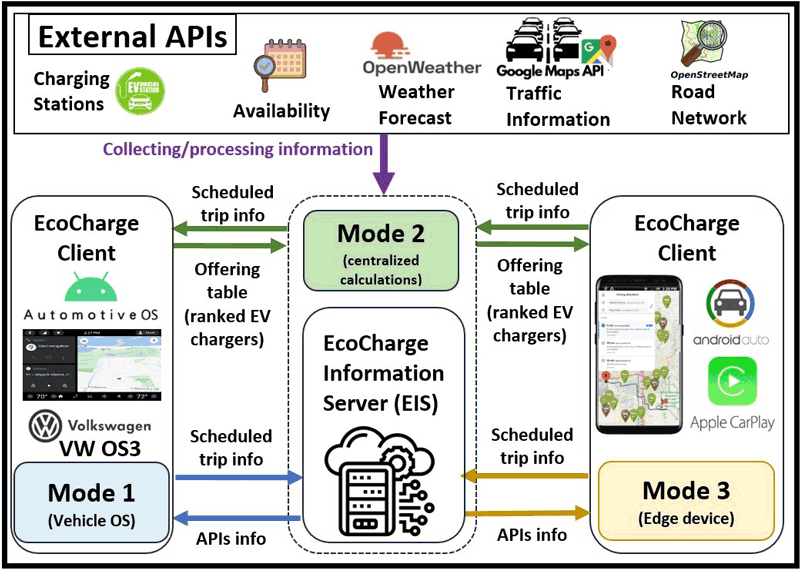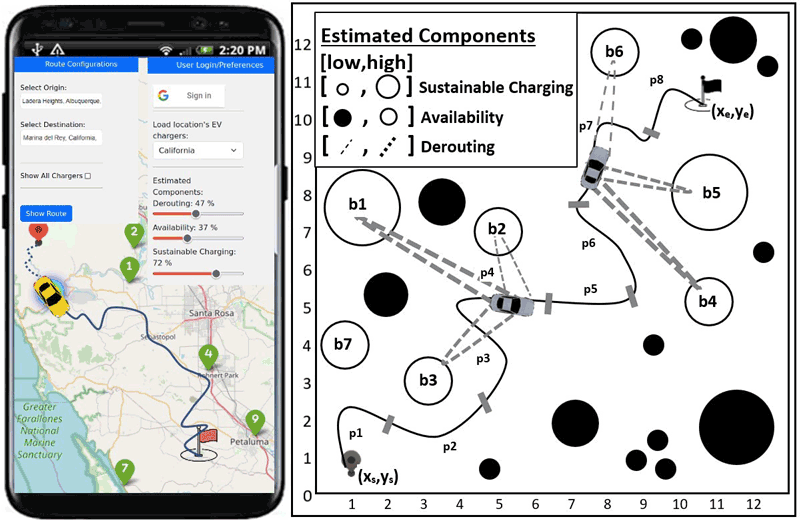by Soteris Constantinou (University of Cyprus), Constantinos Costa (Rinnoco LTD), and Demetrios Zeinalipour-Yazti (University of Cyprus)
The EcoCharge framework, developed at the University of Cyprus, allows eco-friendly electric vehicle charging by utilising an intelligent algorithm to connect drivers with the most environmentally sustainable chargers. This innovative approach enhances the use of renewable energy, minimises CO2 emissions, and optimises charging through a user-friendly mobile GIS application.
Electric vehicles (EVs) and charging infrastructure are rapidly evolving to meet today's demands. Our main objective is to allow drivers to recharge their EVs from the most environmentally friendly chargers through an intelligent hoarding approach. These chargers maximise renewable (e.g., solar) self-consumption, thus reducing CO2 production and also the need for expensive stationary batteries on the electricity grid to store renewable energy that cannot be used otherwise. We have employed a Continuous k-Nearest Neighbour query, where the distance function is computed using Estimated Components (ECs), i.e., a query we term CkNN-EC. An EC defines a function that can have a fuzzy value upon certain estimations. Specific ECs considered in this work include: (i) the (available clean) power at the charger, which depends on the estimated weather; (ii) the charger availability, which depends on the estimated busy timetables that show when the charger is crowded; and (iii) the derouting cost, which is the time to reach the charger depending on estimated traffic. We devised the EcoCharge framework that combines these multiple non-conflicting objectives into an optimisation task providing user-defined ranking means through an intuitive mobile GIS application. Particularly, our algorithm leverages lower and upper values derived from the ECs to recommend the top-ranked EV chargers, displaying them on an intuitive map interface to users.
Over the past few years, there has been a growing interest in the integration of Renewable Energy Sources (RES) with EV charging infrastructure (i.e., photovoltaic panels, wind turbines) [2]. It is common for people to charge their EVs during idle times, even when the battery is not substantially depleted, to ensure that the vehicle will be charged sufficiently for future travel: a behaviour we term “energy hoarding”. EVs are seen as a way to improve the environment and mitigate greenhouse gas emissions; however, energy hoarding with non-renewable energy is negating environmental benefits. In the USA, the EV energy charging demand was attributed to 4.7 terawatt hours in 2020, and is expected to increase to ≈107 terawatt hours by 2035 [3]. Current applications (e.g., Plugshare, Ionity, Tesla’s supercharger, EnBW, Shell recharge) focus on allowing users to know where to recharge, but do not list the environmental impact of the charging process (i.e., energy sourced from fossil fuel burning).
A renewable hoarding technique can be applicable in situations with idle time (i.e., while an EV user is parked or waiting). For example, consider the following real-life scenarios: (i) parents waiting in their idle EVs while their children attend after-school activities; (ii) electric taxis (e.g., Lyft, Uber, Bolt) during idle periods are waiting to be called or booked online; and (iii) an EV user going for groceries or clothing shopping. This can also be applied in similar situations, such as attending meetings, events, or conferences. Consequently, in all aforementioned cases, users could stop or deroute at some nearby charging station to efficiently charge their EVs using power generated from renewable sources, thus reducing the carbon footprint of their daily routine.
The decision of where to sustainably hoard depends on a variety of Estimated Components (ECs) on where and when to charge. Examples of these estimations are: (i) the available clean power at the charger that depends on the estimated weather; (ii) the charger availability that depends on the estimated busy timetables showing when the charger is crowded; and (iii) the derouting cost to reach the charger that depends on estimated traffic. To tackle this challenge, a Continuous k-Nearest Neighbour (CkNN) query can be utilised to answer questions like which EV chargers are closer to a path. Our work falls under the concept of renewable hoarding techniques exploiting ECs. The objective is to optimise EV charging by utilising only RES and focusing solely on short-term travelling (i.e., urban setting). We model the problem as a CkNN-EC query [1] that retrieves the k-nearest neighbours of every point on a path segment (e.g., “find all my nearest EV chargers during my route from source to end point”), while considering ECs by employing a distance function that can express a fuzzy value.
Our innovative framework, called EcoCharge, utilises a CkNN-EC search and a dynamic caching technique to produce Offering Tables featuring sustainable chargers, ensuring timely responses. The ranking is derived from a cost function, employing an iterative deepening process to determine the kNN sets containing EV chargers from the query point within a predefined time window, while considering ECs, expressed through intervals (i.e., ranges of min-max values). EcoCharge can be used over three Modes: (i) Mode 1, operating in a vehicle’s embedded operating system (e.g., Android Automotive OS, Volkswagen OS3); (ii) Mode 2, where calculations are conducted centrally on a server; and (iii) Mode 3, where functionalities are managed by an edge device (e.g., smart phone using Android Auto or Apple CarPlay).

Figure 1: EcoCharge Architecture: The server takes as an input all EV chargers, availability information, weather forecast, road network data, and traffic conditions. The processed data can be provided to the client upon request through three discrete modes of operation.
As shown in Figure 1, the core of the system resides in an EcoCharge client supported by a centralised server, which interacts with external APIs to retrieve essential data. Leveraging external APIs, the EcoCharge Information Server (EIS) acquires real-time weather forecast data, detailed road network information, and a list of all available EV charging stations based on user’s location. This centralised approach enables the server to efficiently consolidate the required data and distribute to individual clients upon request. Our application enhances user experience by integrating with the device’s location services. Users can seamlessly set their desired trip destination and access route information via an intuitive GUI, leveraging the application's functionality for efficient navigation (see Figure 2).

Figure 2: EcoCharge application: An example of an Offering Table (O) for a moving vehicle on a scheduled trip. The ranking selection is determined by each EV charger's rate and solar production curve at a specific time, taking into account the estimated time of arrival (ETA).
The ability to accumulate renewable energy during production periods and take advantage of self-consumption is a key feature, making EcoCharge an environmentally friendly alternative to traditional charging methods. The system allows drivers to make informed decisions and choose the most sustainable charging stations along their scheduled route, while reducing the environmental impact of transportation.
Link:
[L1] https://ecocharge.cs.ucy.ac.cy/
References:
[1] S. Constantinou et al., “A framework for continuous kNN ranking of EV chargers with estimated components,” in 40th IEEE International Conference on Data Engineering (ICDE'24), IEEE Computer Society, pp. 13, 2024.
[2] S. Constantinou et al., “Green planning systems for self-consumption of renewable energy,” in 2022 IEEE Internet Computing (IC'22), IEEE Computer Society, pp. 7, 2022.
[3] S. Constantinou et al., “Green planning of IoT home automation workflows in smart buildings,” in 2022 ACM Transactions on Internet of Things (TIOT '22), vol. 3, pp.30, 2022.
Please contact:
Demetrios Zeinalipour-Yazti
University of Cyprus











